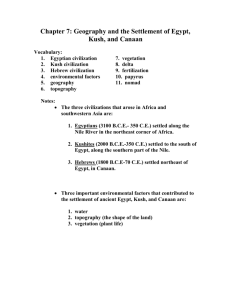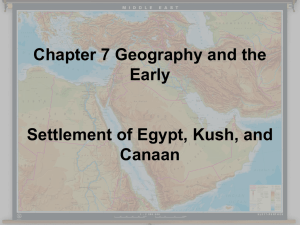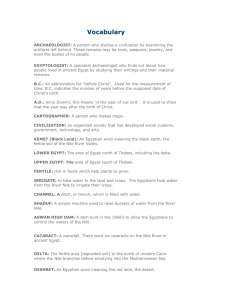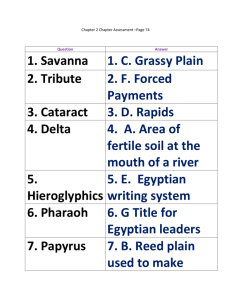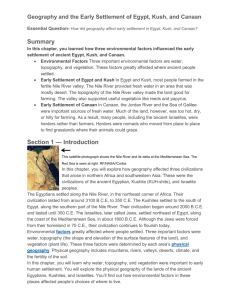File
advertisement
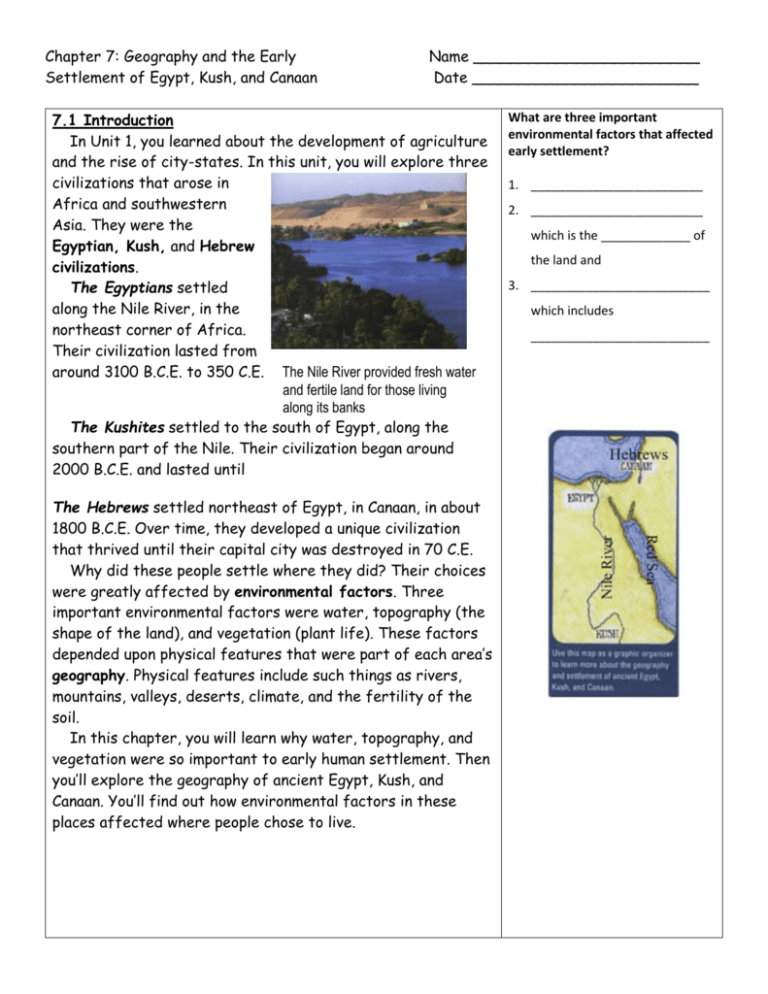
Chapter 7: Geography and the Early Settlement of Egypt, Kush, and Canaan Name ________________________ Date ________________________ 7.1 Introduction In Unit 1, you learned about the development of agriculture and the rise of city-states. In this unit, you will explore three civilizations that arose in Africa and southwestern Asia. They were the Egyptian, Kush, and Hebrew civilizations. The Egyptians settled along the Nile River, in the northeast corner of Africa. Their civilization lasted from around 3100 B.C.E. to 350 C.E. The Nile River provided fresh water and fertile land for those living along its banks The Kushites settled to the south of Egypt, along the southern part of the Nile. Their civilization began around 2000 B.C.E. and lasted until The Hebrews settled northeast of Egypt, in Canaan, in about 1800 B.C.E. Over time, they developed a unique civilization that thrived until their capital city was destroyed in 70 C.E. Why did these people settle where they did? Their choices were greatly affected by environmental factors. Three important environmental factors were water, topography (the shape of the land), and vegetation (plant life). These factors depended upon physical features that were part of each area’s geography. Physical features include such things as rivers, mountains, valleys, deserts, climate, and the fertility of the soil. In this chapter, you will learn why water, topography, and vegetation were so important to early human settlement. Then you’ll explore the geography of ancient Egypt, Kush, and Canaan. You’ll find out how environmental factors in these places affected where people chose to live. What are three important environmental factors that affected early settlement? 1. _________________________ 2. _________________________ which is the _____________ of the land and 3. __________________________ which includes __________________________ 7.2 Environmental Factors and Early Human Settlement Environmental factors influenced where people chose to settle in ancient times. Three important environmental factors were water, topography, and vegetation. Why do you think early settlers would establish their communities near water? Give four specific reasons from the text to support your answer. Water The most important environmental factor in early human settlement was water. Physical features like rivers, lakes, and inland seas are good sources of fresh water. Water is important for many reasons. People need fresh drinking water to live. They also bathe and wash things in fresh water. Bathing and washing help to prevent disease. Water is also a source of food. People catch the fish that live in rivers, lakes, and seas. They hunt water birds and other animals that gather near water. In addition, farmers need water to grow their crops. For this reason, farmers often settled near rivers. The river’s natural flooding could help to irrigate their farms. Farmers could also dig canals or trenches to direct the river’s water to their crops. As you’ve learned, farmers in Mesopotamia dug canals for this purpose. Water can also be used for transportation. Cities and towns often used rivers as “highways.” People traveled in boats to visit relatives and trade goods. Towns near the sea could trade goods with countries far away. ______________________________ ______________________________ ______________________________ ______________________________ ______________________________ ______________________________ ______________________________ ______________________________ ______________________________ ______________________________ ______________________________ ______________________________ ______________________________ ______________________________ ______________________________ Topography A second environmental factor was topography. Topography refers to the shape of the land. It includes features like mountains, hills, plains, and deserts. The topography of an area was important for early human settlement. Farmers usually settled in flat, open areas such as plains and valleys. Large, flat spaces gave them room to grow crops. Also, the rich soil in coastal plains and river valleys was excellent for growing crops. Mountains and deserts were less friendly to human settlement. Steep mountains were hard to cross. Their jagged peaks and rocky land made farming difficult. Deserts were hot and dry. They contained very little water for farming. The intense heat and lack of water made travel difficult. People who settled in mountains and deserts faced many challenges. Why do you think it was best for farmers to settle in flat, open areas? _____________________________ _____________________________ _____________________________ Draw 4 pictures to represent topography in the boxes below Vegetation A third environmental factor was vegetation, or plant life. There are many kinds of vegetation, such as trees, bushes, flowers, grass, and reeds. The crops people grow are also a type of vegetation. Many physical features affect vegetation. Mild weather, regular rain, and fresh water are good for plant life. The areas around rivers and lakes are usually green and lush. Mountains are often covered with thick groves of trees. Deserts, being dry and hot, have very little vegetation. The vegetation in an area influenced early human settlement in several ways. Most important, plants were a source of food. People ate both wild plants and crops they had planted. But vegetation had other uses as well. People learned to make many useful products out of plants, including medicine, baskets, rope, tools, and even paper. Trees provided shade from the hot sun. And plants and flowers helped to make a place beautiful. Water, topography, and vegetation were important wherever people settled in the ancient world. Let’s look now at how these environmental factors influenced the early settlements of Egypt, Kush, and Canaan. Circle three environmental factors in the photograph below: Why was vegetation an important consideration when settling in an area? Give four specific reasons from the text to support your answer. ______________________________ ______________________________ ______________________________ ______________________________ ______________________________ ______________________________ ______________________________ ______________________________ ______________________________ ______________________________ ______________________________ ______________________________ ______________________________ ______________________________ ______________________________ If you were an early settler, describe the ideal physical landscape where you would settle. (Consider the three environmental factors in your description) ______________________________ ______________________________ ______________________________ ______________________________ ______________________________ ______________________________ ______________________________ ______________________________ ______________________________ ______________________________ ______________________________ ______________________________ ______________________________ ______________________________ ______________________________ ______________________________ ______________________________ ______________________________ ______________________________ ______________________________ ______________________________ ______________________________ Nile River “Act it Out” in POD 7.3 Environmental Factors and the Early Settlement of Egypt and Kush The Egyptians and Kushites (also known as the Nubians) both settled near the Nile River. The Egyptians lived along the northern part of the river. The Kushites (Nubians) lived to the south. Why did settlements in these areas cluster around the Nile? Let’s look at the physical features of Egypt and Kush and then see how environmental factors favored settlement near the Nile. Physical Features of Egypt and Kush (Nubia) The most important physical feature in ancient Egypt and Kush was the Nile River. Flowing north from deep in Africa, the Nile created a long, fertile valley that ended in a marshy delta by the Mediterranean Sea. The Nile River valley was surrounded by the Libyan Desert, the Arabian Desert, and the Nubian Desert. These sandy deserts were extremely hot and dry. Most people avoided them, yet the deserts did play one important role in the settlement of Egypt and Kush. They formed a natural barrier that helped protect people living in the Nile River valley. The deserts did not support large settlements, and few invaders wanted to cross them. On the north, Egypt was bordered by the Mediterranean Sea. Settlers could not drink its sparkling salt water, but the sea was rich in fish and other kinds of life. It was also a waterway that linked ancient Egypt to other civilizations. To the east of Egypt and Kush was a long, thin channel of very salty water called the Red Sea. The climate in this area was hot and dry. Much of the land near the Red Sea was desert. delta an area of sediment deposited at the mouth of a river Feature Mediterranean Sea The Deserts The Red Sea The Nile River Africa’s Nile River is the longest river in the world. It is more than 4,100 miles long and flows from south to north, draining into the Mediterranean Sea. PROS+ CONS- Environmental Factors and Human Settlement in Egypt and Kush Environmental factors in ancient Egypt and Kush greatly favored settlement near the Nile River. Most important, the Nile was a source of fresh water in an area that was mostly desert. The lack of water in the deserts made them useless for farming. But in the Nile River valley, the river provided natural irrigation and fertilization. Every summer, the river overflowed its banks. The floodwaters soaked the dry ground. After several weeks, the waters went down. A thin ribbon of silt (rich soil) was left behind. This soil was perfect for farming. Where there is fresh water, there are usually fish to catch and animals to hunt. The abundant wildlife in the Nile region included fish, ducks, geese, hippos, crocodiles, giraffes, and ostriches. The topography of the river valley also encouraged human settlement. In the south, parts of the Nile ran through narrow valleys and hills. But there were also wide areas of flat land around deep bends in the river. These flat areas were good for farming. In the north, wide plains were watered by the Nile’s annual flooding. Vegetation was rare in the dry deserts, but it was plentiful in the Nile River valley. Useful plants included reeds and a tough water plant called papyrus. People wove reeds into baskets and roofs for their huts. They used papyrus to make rope and paper. And the rich farmland made it easy to grow crops like wheat and barley. Deserts are natural barriers against invaders. Would YOU want to walk across this hot, dry desert to fight those who live on the other side? Would it be worth the risk to try? Read the play, Saba the Farmer Read the following song Egyptians sang about the Nile: “When the Nile arises earth rejoices and all men are glad….That givest drink to the desrt places which are far from water.” What is meant from the words in the song? Use details from the text to support you’re answer: ______________________________ ______________________________ ______________________________ ______________________________ ______________________________ ______________________________ ______________________________ ______________________________ ______________________________ ______________________________ ______________________________ ______________________________ ______________________________ ______________________________ ______________________________ ______________________________ ______________________________ ______________________________ ______________________________ ______________________________



